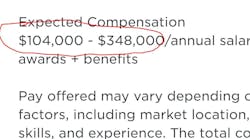A recent Indeed job ad seeking a Distributed Database Engineer for Tesla listed an annual salary ranging from $104,000 - $348,000. A Principal Software Engineer position at Abbott Labs showed a salary range of $125,700 - $251,5000.
Why would companies advertise such wide salary ranges, and are they effective in attracting talent?
Why So Broad?
Eight states, including California, Colorado and New York, have recently passed laws mandating the inclusion of expected compensation in job postings, and more states are considering it. In response, some employers have chosen to post very wide pay ranges for open positions, for several reasons: They do not wish to reveal compensation information to competitors; they wish to retain flexibility to hire at different experience levels; or they hope the high top-of-range value will attract talent.
But my recent research suggests the practice of posting wide salary ranges in job ads can backfire. At Washington State University, my research falls at the intersection of organizational behavior, human resource management, and public policy. While the intent behind pay transparency legislation is to foster greater equity, and greater pay transparency should also help build trust, I recently conducted a series of experiments that show the reality is more complex.
Perceived as Disingenuous
In an evolving job market where job seekers increasingly value transparency, the way companies present compensation information in job postings can have a profound impact on their attractiveness to prospective candidates. Browsing online job boards reveals substantial variation in how employers comply with this legislation, with some listing relatively narrow ranges and others that span hundreds of thousands of dollars.
In my first study, 47, business students responded to a business-analyst job posting. Half viewed a version with a relatively narrow pay range and half saw a wide pay range with the same midpoint.
In the second study, 353 college graduates with relevant work experience evaluated two advertisements, where both the width of the pay range and its explanation (reflecting differences in cost of living across geographic locations or as reflecting differences in candidate qualifications) were counterbalanced.
In the final study, a diverse sample of 245 people with recent job-search experience predicted a salary offer for a hiring scenario in which both the width of the advertised pay range and the chosen candidate’s qualifications were manipulated; they were also asked to give their impressions of the organization.
Results indicate that, on average, job advertisements with a very wide pay range cause an organization to be perceived as less trustworthy. Although this is not necessarily true for every prospective applicant, most people seem inclined to see these broad ranges as signaling a lack of commitment to fair pay or as intentionally misleading.
For example, one Study 3 participant wrote “they are dishonest if they will put a range that high. If they really are paying people in the same position that differently, there is something wrong. So they would be tricky and abusive.”
Taking Explanations Into Account
Interestingly, my findings also suggest that the explanation provided for the salary range’s breadth can significantly influence applicant perceptions. In Study 2, attributing a wide pay range to differences in the cost-of-living across multiple locations increased attraction, whereas explaining it as due to differences in candidate qualifications lowered attraction.
These findings hold critical implications for human-resources professionals and business leaders. In an era where attracting top talent in an extremely tight job market is more competitive than ever, understanding the subtleties of pay transparency’s effects on an employer’s recruiting brand is vital.
While it is widely believed that including compensation information in job postings ultimately benefits both job seekers and employers, my research clarifies that recruitment decision-makers need to think beyond just whether or not to include pay ranges in job postings. They also need to consider what messages the width of the range and any explanation send to job seekers. Advertising realistic pay ranges, along with objective rationales for significant variation (such as presenting separate ranges for New York and San Francisco, as some large corporations now do) should help employers signal trustworthiness.
Moreover, these insights extend beyond specific recruiting practices to broader issues of organizational strategy and culture. They highlight the importance of aligning compensation policies with organizational values and the expectations of the modern workforce.
As companies navigate the complexities of pay transparency, they need to consider effects on both attraction and retention of talent. For example, some employees have taken to social media to flag discrepancies between their current pay and that advertised for new hires.
In sum, my research at Washington State University underscores the nuanced relationships between pay transparency, perceptions of organizational trustworthiness and recruitment. As businesses strive to adapt to new transparency norms and policies, they must be mindful of the signals they send through their compensation practices and policies. Thoughtful, evidence-based practices that go above and beyond the bare minimum of legal compliance can help companies enhance their appeal to job seekers, and recruit more effectively and efficiently.
Kristine Kuhn, Ph.D., is an associate professor in the Department of Management, Information Systems and Entrepreneurship at Washington State University, where she teaches human resource management and negotiation. Dr. Kuhn's research focuses on decision-making in HR, the gig economy, entrepreneurs' advice-seeking and public policy issues related to employment. Her recent research study about salary ranges in job postings appears in the Journal of Applied Psychology.



